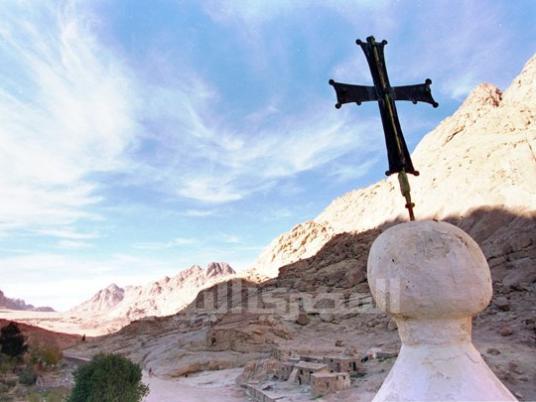Although Ahmed Sedky’s book features charts and graphs, an extended bibliography, and copious footnotes, its target is not a university classroom. It is the crowded, dirty streets of Cairo’s oldest neighborhoods.
This is why Sedky did not intend to write an academic book. “If I promise you quality in terms of thinking and I’m giving you simple logic,” Sedky says in his high pitched, hurried tone, “don’t tell me that it’s academic or its for the normal reader. It’s for those who are interested.”
Living with Heritage in Cairo: Area Conservation in the Arab-Islamic City, released last month by AUC Press, discusses the significance and possible future of what Sedky calls “historic Cairo,” an area extending north-south from Bab el-Nasr to Bab Zuwayla and east-west from the Muqattam Hills to Port Said Street – the area often known to tourists as “Islamic Cairo.” Sedky rejects that name: “There is nothing called ‘Islamic.’ It’s the place that is developed by Muslims. There is a big difference here.”
Living with Heritage in Cairo is both descriptive and prescriptive. In three sections, Sedky lays out what to conserve, why to conserve it, and an assessment of how conservation has worked so far. To make his point he draws on examples of successes and failures from throughout the Arab-Islamic world from Morocco to Syria. And he doesn’t shy away from criticizing the Egyptian government’s approach so far.
Sedky, a Cairo native, is currently a professor at King Fahd University in Saudi Arabia. He received his bachelor’s degree in architecture from Cairo University before getting a master’s degree in Islamic art and architecture from AUC and a PhD in Edinburugh, Scotland. When he met with Al-Masry Al-Youm, Sedky wore a spiffy blue sports coat and gold cufflinks. It is hard to imagine him walking the streets of Cairo’s poorest neighborhoods, but his passion for the subject shines through.
Sedky inherited his passion for historic Cairo from his father, who was from the area.
“It was his passion. He told me, ‘These places were more beautiful than Paris and you have to understand and appreciate that and see the people who are tenuously holding on to what happened before.” With time, Sedky came to appreciate that sentiment and has made it his life’s work.
“The main problem of Cairo’s historic areas is the physical deterioration of every ancient urban fabric,” Sedky writes. A lack of government care for the citizens, coupled with a complex and unresponsive bureaucracy, has created an atmosphere in which people do not cherish the monuments among which they live. The result is a decaying historic area.
But conserving historic Cairo is not just a matter of fixing the cracked walls of ancient mosques. It is also about preserving communities and cultures. There are both tangible and intangible aspects of historic areas that must be conserved, according to Living with Heritage in Cairo.
The book fully appreciates the effects that a physical environment has on the people who live there. Sedky uses the example of the bent entrance in classic Islamic architecture, which preserves the family’s privacy. When people moved into modern European-style houses, they incorporated this sense of privacy into the way they interacted with their new living rooms.
Because Sedky understands the effect of the urban environment on the community, he also understands the effect of the community on the urban environment. Involving these communities, he believes, is the key to effective conservation. “Even if you force me and impose something on me,” he says of external attempts to impose responsible conservation, “I would wait and I would ruin everything the moment you take your squad out of my area. Give me a couple of years and I’ll ruin everything once again.” Strength and sustainability are to be found within the community.
But so far, Egypt has taken an opposite approach. Rather than involving the community and trying to preserve the traditional urban fabric, it has implemented its attempts at conservation from the top down, with the government leading the way and focusing its conservation on maximizing tourism.
“In Cairo and other places,” Sedky writes in the conclusion of Living with Heritage in Cairo, “there is insufficient government concern for the cultural values, or the environmental and social needs, of the local communities.” This has contributed to the decay of Cairo’s historic centers.
A successful conservation plan, according to Sedky, will involve flexibility on the part of the conservationists. There are times when people must be evicted from their neighborhoods to protect extraordinarily important historic sites. And there are times when protecting the local community takes precedent over all else. The key, however, is careful deliberation and a thorough understanding of the complex issues at stake.
Living with Heritage in Cairo, despite Sedky’s stated goals, is not light reading. The book’s discussions of sociology and architecture can be quite esoteric at times. But the lessons that he offers are crucial nonetheless.
Today, downtown Cairo is undergoing its own transformation. While downtown is not as ancient as other parts of the city, it isn’t lacking in historic value. As new businesses move into the area and wealthier Cairenes move to the outskirts of the city, it seems possible that the mistakes of historic Cairo could be repeated downtown. Unless, of course, everyone heeds the lessons Sedky’s book has to offer.




